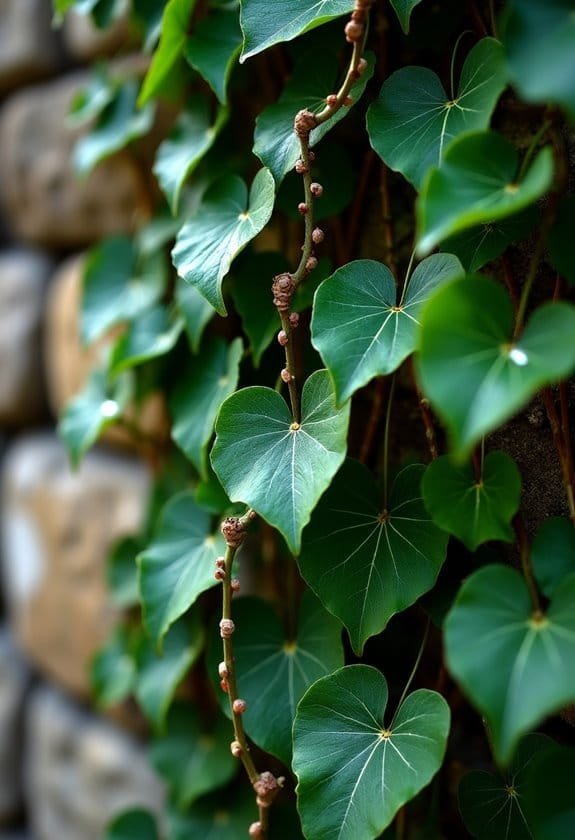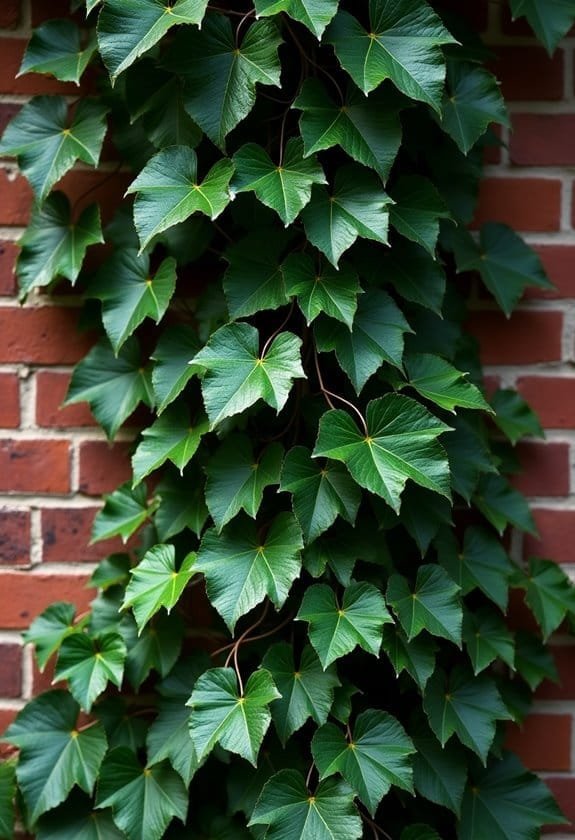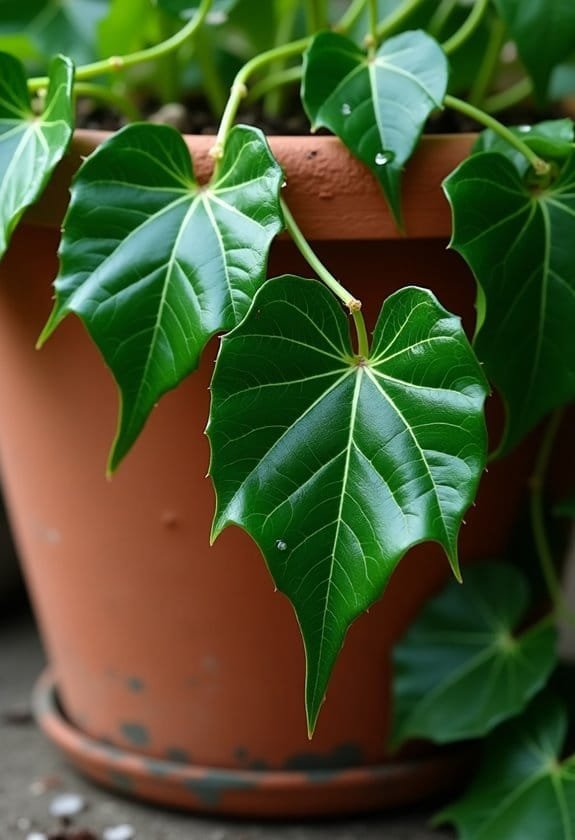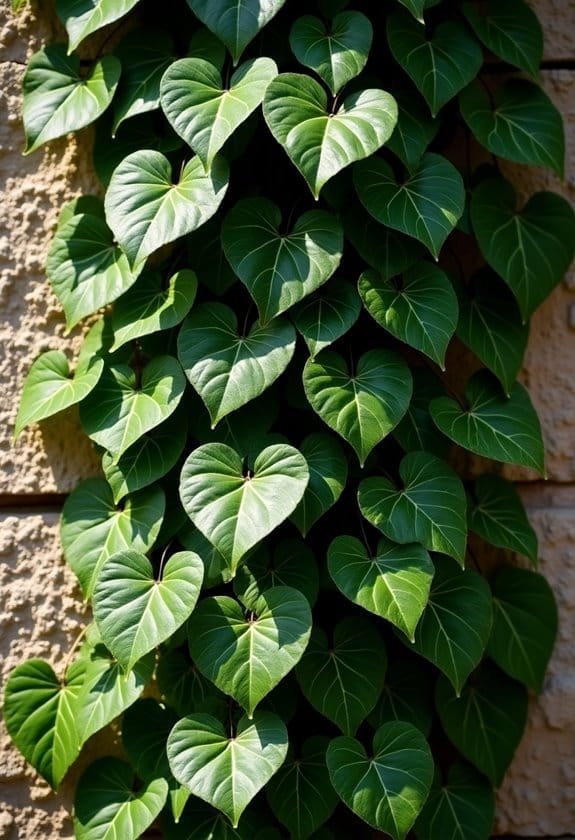Common ivy (Hedera helix) is a versatile evergreen vine that can climb 20-80 feet through both horizontal and vertical growth patterns. It's characterized by two distinct growth phases: juvenile forms with lobed leaves and mature forms with heart-shaped foliage. Native to Europe and Western Asia, this member of the Araliaceae family thrives in partial to full shade and well-draining acidic soil with pH 6.0-7.0. While it provides essential ecological benefits as a late-season nectar source for pollinators and winter berries for birds, its aggressive growth habits demand careful management to prevent overwhelming native species. Understanding its dual nature reveals both its garden potential and necessary precautions.
Main Points
- Common Ivy is an evergreen climbing vine reaching 20-80 feet, with distinctive juvenile and mature growth forms displaying different leaf shapes.
- The plant thrives in partial to full shade, preferring rich, well-draining acidic soil with pH between 6.0 and 7.0.
- Mature plants produce greenish-yellow flowers in late summer and black berries in winter, providing food for wildlife.
- While valuable for biodiversity, Common Ivy is considered invasive in many regions due to its aggressive growth habits.
- Regular pruning, proper watering, and pest monitoring are essential for maintaining healthy ivy growth and preventing structural damage.
Introduction

Common ivy (Hedera helix) stands as one of the most recognizable climbing vines in the world, with its distinctive lobed leaves and vigorous growth patterns earning it widespread recognition across Europe and North America.
As a member of the Araliaceae family, this evergreen climber manifests in two distinct growth forms: a juvenile stage with characteristic star-shaped leaves and a mature phase featuring unlobed, heart-shaped foliage.
While its ornamental appeal has led to its cultivation in gardens worldwide since its introduction to North America in 1727, the plant's aggressive growth habits and toxic properties require careful consideration in landscape management.
Common Name
English Ivy, or *Hedera helix*, stands as one of the most recognizable climbing plants in the world. This versatile evergreen has earned its widespread recognition through its remarkable ability to scale walls and structures, reaching impressive heights of up to 80 feet.
The name "ivy" itself carries a rich historical lineage, deriving from the Classical Latin word *Hedera*, which has remained remarkably consistent throughout the centuries.
While commonly known as English Ivy in most English-speaking regions, this adaptable plant belongs to the Araliaceae family and displays two distinct growth phases throughout its lifecycle.
In its juvenile form, the plant exhibits characteristic lobed leaves that many associate with traditional ivy appearances, while its adult form develops unlobed, heart-shaped foliage.
Despite its popularity as an ornamental plant in gardens and landscapes worldwide, this common ivy species has demonstrated an aggressive growth pattern that's led to its classification as an invasive species in various regions, including parts of North Carolina, where its vigorous growth can overwhelm native vegetation.
Scientific Name
Scientifically designated as *Hedera helix*, this adaptable vine belongs to the Araliaceae family within the order Apiales. The nomenclature reflects both its ancient origins and distinctive growth patterns, with *Hedera* deriving from the Classical Latin word for ivy, while *helix* stems from Ancient Greek, describing its spiraling, climbing nature.
This evergreen species showcases remarkable botanical features that are encoded in its scientific classification. The binomial name perfectly captures the plant's defining characteristics: its tenacious climbing ability and spiral growth pattern.
Through a fascinating display of dimorphism, *Hedera helix* produces two distinct leaf forms throughout its life cycle, shifting from juvenile lobed leaves to mature heart-shaped foliage.
The scientific designation also helps distinguish this particular species from other members of the *Hedera* genus, highlighting its unique reproductive strategy.
The plant's production of greenish-yellow blooms in late summer, followed by black fruits containing stone-like seeds, represents a successful evolutionary adaptation that facilitates bird-mediated dispersal, enabling the species to establish new colonies across diverse habitats.
Overview
Among the most adaptable and widespread climbing plants, *Hedera helix* has earned its reputation as both a cherished ornamental vine and a potentially aggressive invader. Commonly known as English Ivy (Hedera), this evergreen vine demonstrates remarkable versatility in its growth patterns, capable of scaling heights up to 80 feet in outdoor environments.
Native to Europe, Western Asia, and Northern Africa, this member of the Araliaceae family exhibits two distinct growth phases throughout its lifecycle. The juvenile form displays characteristic lobed leaves, while the mature form develops unlobed, heart-shaped foliage that maintains its deep green coloration year-round.
While its aesthetic appeal has made it a popular choice for urban landscaping, the plant's invasive species status in many regions, including North Carolina, raises significant ecological concerns. The vine's aggressive growth habit allows it to overwhelm native vegetation, creating dense mats that can smother indigenous plants and trees.
Additionally, the plant carries important safety considerations, as its leaves and berries contain toxic compounds that pose health risks to both humans and animals, necessitating careful management in residential and public spaces.
Key Features
Common Ivy stands as a remarkable climber, reaching impressive heights between 20 to 80 feet with its characteristic juvenile and adult growth forms.
During its late summer flowering period, the plant produces clusters of modest greenish-yellow blooms that transform into dark, fleshy fruits by winter.
Its distinctive appearance stems from its dimorphic foliage, featuring lobed leaves in its juvenile stage that evolve into unlobed, heart-shaped leaves as the plant matures.
Growth Size
As a vigorous climbing vine, common ivy (*Hedera helix*) can reach impressive heights of 20 to 80 feet in outdoor environments. The plant's remarkable climbing stems and rapid growth rate enable it to establish itself within just a few months, making it an exceptionally efficient vertical climber in suitable conditions.
This adaptable species exhibits two distinct growth forms throughout its development cycle, demonstrating its sophisticated growth strategy. During its juvenile phase, the plant produces lobed leaves that help it establish ground coverage and initiate vertical climbing.
As it matures, the foliage transforms into unlobed, heart-shaped leaves, marking its shift to reproductive maturity. The ivy's vegetative spreading capability allows it to expand horizontally as well as vertically, with stems readily rooting upon contact with soil.
In ideal growing conditions, particularly in partial to full shade with rich, acidic, loamy soil, common ivy thrives and can quickly colonize extensive areas. This dual-direction growth pattern, combined with its swift establishment rate, enables the plant to achieve substantial coverage in both vertical and horizontal dimensions.
Appearance
The distinctive features of Hedera helix make it instantly recognizable in both gardens and wild settings. Its appearance is characterized by a remarkable dimorphism, displaying two distinct leaf forms throughout its life cycle. The juvenile form exhibits deeply lobed leaves with pronounced veining, creating an intricate pattern that captivates observers.
As the ivy matures, its appearance undergoes a striking transformation. The once-lobed leaves develop into simpler, oval to heart-shaped forms, demonstrating the plant's adaptive capabilities.
Along its climbing stems, specialized adhesive roots emerge, forming a network of tiny "feet" that enable the plant to scale vertical surfaces with remarkable efficiency. These aerial rootlets, appearing as fine, russet-colored hairs, contribute to the plant's distinctive texture.
During late summer, the ivy's appearance is enhanced by clusters of modest, greenish-yellow flowers that emerge among the foliage. These blooms later give way to glossy black berries, which persist through winter months, providing visual interest when other plants have shed their leaves.
The overall effect creates a tapestry of varying textures and shapes that change subtly with the seasons.
Flowering Season
Flowering patterns of Hedera helix reveal a distinct seasonal rhythm that enhances its visual appeal. As late summer approaches, mature ivy plants begin their transformation, producing clusters of small, greenish-yellow blooms arranged in distinctive umbel formations. These flowering stems emerge primarily between September and November, marking the plant's reproductive phase.
The flowering season represents an essential period in the ivy's lifecycle, as only mature plants develop these delicate blooms. While juvenile forms focus on vegetative growth, established specimens redirect their energy toward flower production, creating important resources for local ecosystems.
The modest flowers, though not particularly showy, serve as key late-season nectar stations for numerous pollinating insects preparing for winter dormancy. Following successful pollination, the plant develops small, fleshy berries that ripen to a deep black color between November and January.
This timing creates a natural continuation of food sources for wildlife throughout the colder months. The sequential progression from flowers to berries demonstrates the plant's sophisticated adaptation to seasonal changes, contributing considerably to biodiversity during a period when other flowering plants have ceased blooming.
Growing Requirements

English ivy flourishes in partial to full shade conditions, making it an excellent choice for gardens with limited sunlight exposure.
The plant requires rich, well-draining acidic soil with a loamy texture, and gardeners should maintain consistent moisture levels while being careful to avoid waterlogged conditions that can lead to root decay.
For peak growth, temperatures between 70-90°F are ideal, particularly during the spring planting season when the plant establishes its root system most effectively.
Light
Growing common ivy successfully depends heavily on providing appropriate light conditions. This adaptable plant demonstrates a remarkable preference for partial to full shade environments, making it an excellent choice for areas that receive minimal direct sunlight. In these low-light conditions, the ivy's characteristic leaves develop rich coloration while maintaining robust growth patterns.
While common ivy can tolerate some sun exposure, excessive direct sunlight poses considerable risks to the plant's health and appearance. When subjected to intense sunlight, particularly during peak afternoon hours, the foliage becomes susceptible to leaf scorch, manifesting as brown, crispy edges and reduced overall vigor.
The plant's natural habitat beneath forest canopies has evolved it to thrive in filtered light conditions. For ideal growth, positioning ivy in locations that receive bright, indirect light or dappled shade throughout the day proves most successful. Under these favorable lighting conditions, the plant's growth rate accelerates markedly, requiring vigilant monitoring to prevent excessive spread.
Morning sun exposure is generally well-tolerated, provided the plant receives adequate shade during the hotter afternoon hours.
Soil
Beyond lighting conditions, the success of common ivy hinges on proper soil composition. English ivy demonstrates a marked preference for rich, acidic, loamy soil that strikes an ideal balance between fertility and drainage. The plant's root system thrives in soil with a pH range of 6.0 to 7.0, which facilitates efficient nutrient uptake and promotes vigorous growth.
Proper moisture management within the soil plays an essential role in the plant's development. While well-drained conditions are critical, the soil should retain enough moisture to support healthy growth without becoming waterlogged.
Gardeners should allow the soil to approach slight dryness before watering, as this practice encourages robust root development and prevents the onset of destructive root rot. The incorporation of organic matter serves as a soil enhancement strategy, improving both its structural integrity and nutritional content.
This amendment process creates an environment where ivy's roots can effectively establish themselves while accessing essential nutrients. The resulting soil composition acts as a foundation for the plant's long-term health, supporting its characteristic vigorous climbing and spreading growth patterns.
Water
Proper watering sits at the heart of successful ivy cultivation, requiring a careful balance between moisture provision and prevention of waterlogged conditions. The key lies in monitoring the top inch of soil, which should feel dry to the touch before the next watering session, ensuring the well-drained soil maintains favorable moisture levels without becoming saturated.
During the plant's active growing season in warmer months, ivy demands more frequent watering to sustain its vigorous growth patterns and maintain essential humidity levels. As temperatures drop, however, watering frequency should be adjusted accordingly to prevent oversaturation.
Regular misting of the foliage serves as a vital supplement to soil moisture, particularly in indoor environments where humidity levels tend to fluctuate. Vigilance against overwatering remains paramount, as excessive moisture creates an ideal environment for root rot and various pest infestations.
The plant's response to water management manifests in its overall health, with proper hydration resulting in lustrous foliage and robust growth, while poor watering practices often lead to yellowing leaves and stunted development.
Temperature
For ideal growth, English ivy flourishes within specific temperature parameters, thriving in conditions between 70°F and 90°F (21°C to 32°C). This temperate-loving plant demonstrates remarkable adaptability to moderate climates, though it requires careful temperature management for peak development.
During the growing season, maintaining stable temperatures proves essential, as fluctuations can greatly impact the plant's health and growth patterns. While English ivy can withstand brief exposure to lower temperatures, its growth becomes noticeably hampered when temperatures drop below 32°F (0°C).
The plant's cold tolerance reaches its limit at -23.3°C (-9.9°F), beyond which survival becomes unlikely.
Interestingly, English ivy benefits from cooler nighttime temperatures when grown indoors, which mirrors its natural habitat conditions. These temperature variations, when controlled, can enhance the plant's overall health and vigor.
To support peak growth, maintaining appropriate humidity levels through regular misting or environmental controls complements the temperature requirements, creating an environment where this versatile vine can truly flourish.
Pollinator Criteria
Common ivy serves as a crucial nectar source for over 70 species of pollinators, including bees, hoverflies, and wasps, which depend on its late-blooming flowers for sustenance.
The plant's greenish-yellow blossoms emerge during a critical period from late summer through early fall, offering essential nutrition when other flowering plants have completed their cycles.
Through this timing and its abundant nectar production, ivy creates a bridge of sustenance that helps pollinator populations prepare for winter, strengthening the resilience of local ecosystems.
Attracted Pollinators
The greenish-yellow flowers of ivy serve as an indispensable late-season nectar source for numerous pollinating insects. During the critical period from late summer through early fall, when most flowering plants have finished blooming, ivy's abundant flowers become a significant food source for diverse insect species preparing for winter.
Bees, wasps, and hoverflies are particularly drawn to ivy's nectar-rich blooms, which provide these pollinators with much-needed sustenance before hibernation. The timing of ivy's flowering period creates a key bridge in the ecological calendar, supporting insect populations when alternative food sources become increasingly scarce.
Beyond its role as a nectar provider, ivy maintains a complex relationship with various species of butterflies and moths, whose larvae depend on the plant for survival.
This intricate web of ecological interactions extends beyond the growing season, as ivy's dark berries, which ripen from November through January, become a significant winter food source for numerous bird species, including thrushes and blackcaps. This demonstrates the plant's year-round significance in supporting local biodiversity.
Pollination Method
Building on its role as a vital nectar source, ivy's pollination process showcases remarkable adaptability through both self-pollination and cross-pollination mechanisms. The plant's hermaphroditic flowers contain both male and female reproductive structures, enabling successful reproduction even when pollinators are scarce.
During the late summer to early fall flowering period, ivy's clustered arrangement of small, greenish-yellow flowers creates an efficient landing platform for diverse pollinators. These flowers, typically measuring just a few millimeters across, produce abundant nectar that attracts honeybees, hoverflies, and wasps, which transfer pollen between different ivy plants.
The strategic timing of ivy's blooming coincides with insects' pre-winter foraging activities, establishing a mutually beneficial relationship between plant and pollinator.
Following successful pollination, the flowers develop into berries, completing the reproductive cycle through ornithochory – seed dispersal by birds. This dual approach to pollination, combining both insect-mediated cross-pollination and self-pollination capabilities, guarantees ivy's reproductive success across various environmental conditions and contributes to its widespread distribution in diverse habitats.
Care & Maintenance

English ivy's successful growth begins with proper planting in well-draining, loamy soil and careful placement in partial to full shade locations.
Regular maintenance includes spring pruning with sanitized shears to encourage bushiness, alongside consistent monitoring for common pests like aphids and spider mites that can compromise plant health.
For ideal development, gardeners should maintain soil moisture without overwatering, consider companion plants that thrive in similar conditions, and guarantee adequate humidity through regular misting when grown indoors.
Planting Tips
Growing common ivy successfully requires attention to its specific environmental needs and care requirements. When you plant English ivy, selecting the right location is essential, as this versatile ground cover performs best in areas with partial to full shade, though it can tolerate full sun in cooler climates.
The soil preparation plays an important role in establishing healthy ivy growth. Create a well-draining, loamy soil bed enriched with organic matter, which provides the essential nutrients and moisture retention properties these plants need.
When planting, space individual plants 18-24 inches apart to allow for proper spread and development, considering their vigorous growth habit.
For container planting, choose pots with adequate drainage holes and use a high-quality potting mix. The planting depth should align with the plant's previous growing level, neither too deep nor too shallow.
During the establishment period, maintain consistent moisture levels through regular watering, and apply a balanced 20-20-20 fertilizer to support robust root development and foliage growth.
Consider laying a thick layer of mulch around newly planted ivy to retain moisture and suppress weed growth.
Ongoing Care
Once established, common ivy requires regular attention to maintain its appearance and prevent unwanted spread. The key to successful ongoing maintenance lies in consistent pruning practices, particularly during the spring season when growth is most vigorous. Regular trimming helps maintain the plant's bushy shape while preventing it from overwhelming nearby vegetation or structures.
For ideal results, gardeners should focus on pinching off growing tips, which encourages lateral branching and creates a fuller, more aesthetically pleasing appearance. This practice also enhances air circulation throughout the plant, reducing the risk of fungal diseases that can compromise its health.
When managing ivy that has climbed trees, it's important to sever vines at their base rather than forcefully removing them, as this could damage the tree's protective bark layer.
Appropriate care for indoor specimens demands careful attention to environmental conditions. Maintaining proper humidity levels, implementing a balanced watering schedule, and providing adequate light are vital components of indoor ivy cultivation.
These practices, combined with vigilant monitoring and timely intervention, guarantee that common ivy remains an attractive and manageable addition to any landscape or interior space.
Suggested Companions
Successful companion planting with common ivy requires careful selection of plants that share similar growing conditions while promoting mutual benefits. Virginia creeper and golden ragwort stand out as excellent companion plants, as they're non-toxic and contribute to the garden's biodiversity without competing aggressively for resources.
When designing an ivy-inclusive garden space, ferns and hostas make ideal companions due to their shared preference for shaded areas and similar soil requirements. These plants create a harmonious understory that complements ivy's aggressive growth patterns while maintaining their distinct territories through proper spacing and regular maintenance.
The strategic grouping of these species can also enhance natural pest control, as companion plants attract beneficial insects that help manage common ivy problems like aphids and spider mites. Regular pruning remains essential when combining ivy with other plants, ensuring that its vigorous growth doesn't overwhelm its companions.
Is Common Foxglove Toxic Like Common Ivy?
The question of whether the common foxglove is as toxic as common ivy arises often. While both can be harmful, the common foxglove’s toxins are notably potent and impact the heart. For accurate guidance on its properties and risks, reliable sources of common foxglove plant information should always be consulted.
Common Issues
English ivy faces numerous challenges from both pests and diseases that can greatly impact its health and growth.
Common invaders include sap-sucking insects like aphids and mealybugs, which weaken the plant by extracting nutrients from its tissues and leaving behind sticky residue.
Fungal and bacterial infections, particularly powdery mildew and leaf spot diseases, can be managed through proper air circulation, reduced watering overhead, and the targeted application of appropriate fungicides when necessary.
Pests/Diseases
Like many plants, common ivy faces several pest and disease challenges that can impact its health and appearance. Among the most troublesome pests are aphids, spider mites, mealybugs, and caterpillars, which can greatly compromise the plant's vitality if left unchecked.
Regular monitoring serves as the first line of defense, allowing gardeners to identify and address infestations before they become severe.
Bacterial leaf spot presents itself as dark brown or black lesions on the foliage, requiring prompt removal of affected plant material to prevent the infection from spreading to healthy areas.
Root rot, a particularly devastating condition that thrives in warm, humid environments, can prove fatal if not addressed early through proper moisture management and fungicide applications.
Fortunately, several treatment options exist for these common problems. A solution of dish soap and water proves effective against aphids, while neem oil and insecticidal soap offer broader protection against various pests.
These treatments, combined with proper cultural practices like adequate air circulation and appropriate watering, help maintain the ivy's robust health and aesthetic appeal.
Solutions
Tackling common ivy issues requires a systematic approach to control and management. When dealing with English ivy's aggressive growth patterns, several effective methods can help maintain control over these persistent climbers. Hand-pulling remains the most straightforward solution for small infestations, particularly when the soil is moist enough to facilitate complete root removal.
In urban areas, where ivy often poses significant structural threats to buildings and landscapes, implementing a multi-faceted control strategy becomes vital. For extensive overgrowth, cutting vines several feet above ground level and applying systemic herbicides proves highly effective at managing large-scale invasions.
Groundskeepers and property owners should employ heavy-duty rakes to uproot ground-covering vines, ensuring thorough removal by cutting close to the soil surface. Regular monitoring plays a significant role in preventing ivy from encroaching into unwanted spaces, while proper disposal techniques are equally important.
To prevent further spread, collected vines should be thoroughly dried before disposal in regular waste containers, as even small fragments can potentially establish new growth when conditions are favorable.
Summary

Common ivy (*Hedera helix*) stands out as a formidable evergreen climbing vine that's both admired and feared in horticultural circles. As an invasive species capable of reaching heights up to 80 feet, this versatile plant has established itself as both a beloved ornamental plant and a significant ecological concern in many regions.
The plant's dual nature becomes evident in its contrasting characteristics: while its antimicrobial properties and aesthetic appeal have made it a historical favorite, its aggressive growth patterns and toxic properties present serious challenges.
The vine's ability to transform from juvenile forms with lobed leaves to mature forms with unlobed foliage demonstrates its remarkable adaptability, though this versatility often comes at the expense of native flora.
Today's management approaches reflect this complexity, as property owners and conservationists must balance the plant's ornamental value against its potential for structural damage and ecological disruption.
Whether viewed as a traditional garden element or an environmental threat, common ivy continues to demand careful consideration in landscape management, requiring vigilant control measures to prevent its unchecked spread.


